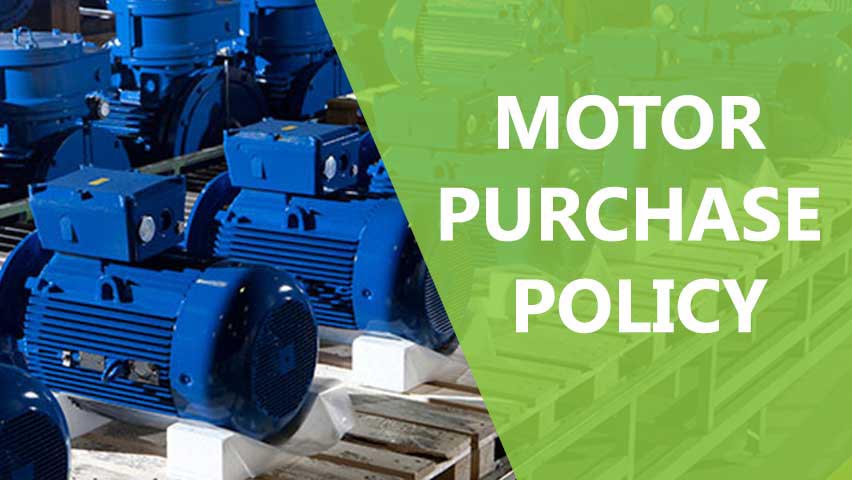Perhaps you’ve decided to replace your failed motor with a new one rather than repair it. Or maybe you’re looking to buy new equipment for an expansion, or opting to retire a motor before fails. What’s your plan for selecting the right motor?
A motor purchasing policy guides these decisions, making sure they align with your company’s initiatives and objectives — whether energy efficiency is the goal or achieving a certain payback period drives decisions.
At a minimum, your comprehensive motor purchasing policy should:
- Standardize motor specifications
A motor specification list serves as purchasing’s cheat sheet for new motor purchases.
At a minimum, your standard motor specifications should address design criteria — such as motor type, frame size, mounting, orientation, voltage, and line frequency — as well as performance characteristics, including size (Hp), speed, maximum allowable slip, KVA code, and minimum efficiency. [i]
Those who have adopted lean principles may bristle at the idea of standardizing motor specs — after all, one tenet of lean includes stripping away constraints to allow maximum flexibility and responsiveness. But, standardizing the sizes and types of motors you use will reduce the number of different spares, parts, and supplies (e.g., grease) you need, enabling leaner spares and supplies inventories.
Standardization also streamlines maintenance by minimizing the number of exceptions around the plant. Imagine being able to pluck a ‘standard’ 10 Hp motor off the inventory shelf — or, in a real pinch, off a piece of non-critical equipment — and have it fit in your critical application. Hence, a standard motor specification streamlines the motor-purchase process and supports consistent and reliable operations.
If your motors operate in a harsh environment or frequently fail, consider specifying severe-duty (IEEE-841) motors to increase warranty and improve reliability.
The Energy Independence and Security Act (EISA 2007) raised minimum efficiency standards to NEMA Premium levels, yet higher efficiency options exist. And with escalating power rates, these super-premium efficiency options are increasingly cost-effective. Consider, for example, copper-rotor and permanent-magnet motors, which provide higher efficiencies than NEMA Premium with less slip. Just don’t forget to evaluate whether these motors’ energy benefits justify their higher purchase price.
- Establish the methodology & financial criteria for evaluating motor purchases
Specifying which tools to use to evaluate the cost-effectiveness of motor purchases and the financial criteria that purchases must meet to justify higher-efficiency purchases, such as a two-year payback period, ensures that purchasing will consistently select the option with the highest energy savings and return on investment.[ii]
Don’t forget to outline how to find out whether your motor purchases qualify for government & utility energy program rebates and incentives.
Also, identify if you have any preferred vendors. Developing relationships with one or two preferred vendors can yield deep discounts (20 – 60% off MSRP) — particularly if you purchase your motors in bulk. Motor vendors / distributors can also be invaluable in anticipating your future motor needs, sharing storage space, and providing cross-referencing replacement recommendations. By maintaining an inventory of critical spares, minimizing storage and handling costs, and ensuring quick turnaround time, your relationship with a preferred motor vendor can help you lower costs on more energy-efficient models to the point where it meets your financial criteria.
- Remember your small motors
Which consumes more energy: one 200 Hp motor or two-hundred 1 Hp motors? [It’s the latter, hands down (157 kW vs. 175 kW per hour of operation).]
In my experience, many facilities underestimate the number of motors and total connected horsepower in their portfolio because they forget about the small (< 5 Hp) motors. People tend to notice the 20% of their inventory that qualify as large motors and forget about the remaining 80%. However, smaller motors are far less efficient than bigger motors. Replace these motors with premium efficiency motors to redeem significant energy savings.
A comprehensive motor purchasing policy streamlines your purchasing process and helps you make more effective motor-management decisions. For more information on how our software can help you proactively plan for or prevent future motor failures, contact us at info@motorsatwork.com.
[i] https://www.advancedenergy.org/portal/mad/images/pdf_documents/MAD_Horsepower_bulletin_final.pdf
[ii] https://www.copper.org/environment/sustainable-energy/electric-motors/case-studies/a6148.html


